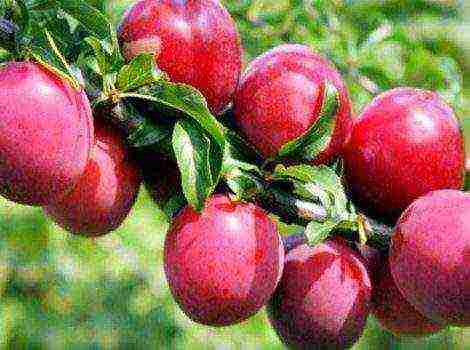How to properly grow hazelnuts from walnuts at home?
It's hard to find someone who doesn't like chocolate or hazelnut candy. These small nuts not only have a pleasant taste, but also have a beneficial effect on the human body.... The high content of vitamins, chemical elements and amino acids improves health in case of anemia, chronic fatigue, diabetes, neuroses and heart diseases. Hazelnut oil contained in nuts, supplying the body with vitamin E, restores vitality and has a rejuvenating effect. Eating hazelnuts in food is equally beneficial for children and older people. Let's take a closer look at this plant, with the features of the care and cultivation of hazel at home.
There is no industrial cultivation of hazelnuts in our country. Valuable fruits are imported mainly from Turkey, Italy, Spain and China. But hazelnuts are not as exotic as they seem. It is a cultivated form of common hazel, which grows under natural conditions in the Caucasus, the Middle East, Ukraine and throughout the European territory up to northern latitudes. So why not grow this unpretentious and useful plant in your country house, because planting hazelnuts is an excellent business prospect and investment in your health.
Hazelnut - a cultural form of hazel on the site
Growing hazelnuts for a gardener won't be a big hassle. No wonder the Italians call "cultivated hazel" a plant for the lazy. Hazelnut is a shrub that reaches 2-5 m in height depending on the variety, but can be formed by pruning in the form of a tree - the choice depends on the owner of the site.
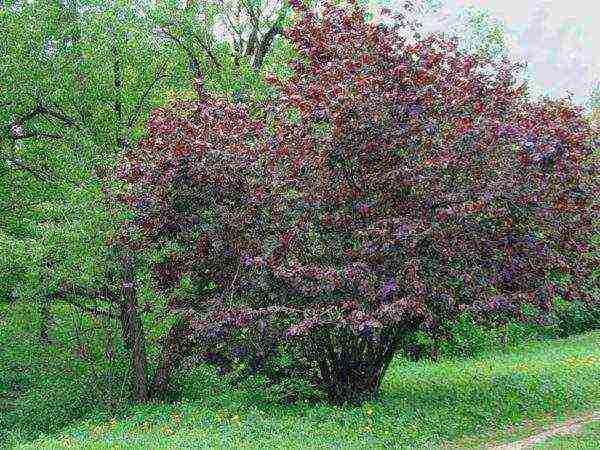
The first harvest can be expected already at 3-4 years after planting a seedling... The plant does not need particularly careful care, because in natural conditions, hazel grows well without human help. After planting, agricultural technology is reduced to watering, removing root shoots, annual pruning, and pest control if necessary.
Hazelnuts planted on the site will supply fruits with high nutritional properties and useful substances for decades. Mass harvesting of nuts starts with 5-7 years plant life and lasts for 10-15 years old... After that, the plant is "rejuvenated" - for several years in a row, 2-3 old branches are cut off, which are eventually replaced by young ones and begin to bear fruit generously.
From each adult hazelnut, subject to agrotechnical practices get 5-12 kg fruitthat can be stored for a long time (1-3 years) without sacrificing taste. If you plant at least three plants on the site, the annual harvest will look quite significant.
In addition to the benefits of harvesting, the plant has a high decorative effect. Hazelnut varieties have leaves of different colors and sizes., therefore, gardeners often practice planting variegated bushes in a row - with red, yellow and green foliage. Hazelnuts also look spectacular as a specimen plant, formed in the form of a tree.Aesthetic lovers will appreciate the beauty of the bush that throws out spectacular earrings that attract bees in early spring.
Reproduction of hazelnuts at home
Lovers of growing a tree from a nut may well resort to the seed method of reproduction. It is uncomplicated and, subject to the necessary requirements, will allow you to get a strong and healthy plant. However, such hazelnuts will begin to bear fruit much later than the one grown from a seedling. If, when planting a seedling, the first nuts appear on 3-4 years after planting, then the plant grown
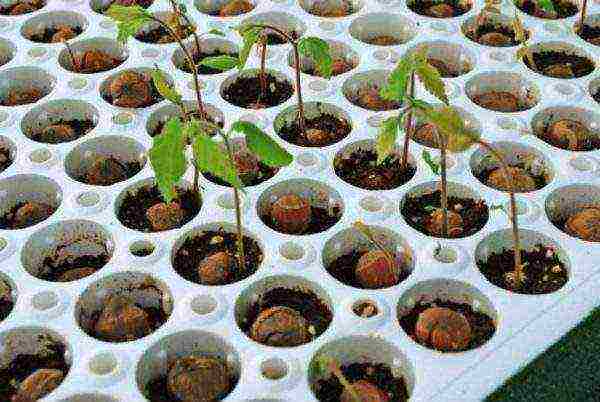
from walnut, bears fruit for 6, or even for 10 year.
Therefore, gardeners are more likely to use the planting of seedlings. With this method of reproduction, in contrast to planting a nut, all varietal characteristics of hazelnuts are preserved, based on which they choose a plant suitable for certain conditions.
Sapling selection
One- or two-year-old seedlings are selected for planting. It is recommended to give preference to winter-hardy and drought-resistant varieties.... The purchase of a seedling in a local nursery guarantees the receipt of zoned varieties adapted to the climatic conditions of the region.
When choosing hazelnut seedlings in a nursery or garden center, you need to carefully examine the root system of the plant. It should be well developed and free from damage. Slightly damaged roots are cut to a healthy place... If there is a lot of damage, you should refuse to buy a seedling, since a strong pruning can affect the survival rate and lead to the death of the plant.
Choosing a landing site
Hazelnut is considered a plant that is unpretentious to the composition of the soil and terrain. Moderately fertile soil and a sufficient amount of moisture are favorable for the development of the plant and the future abundant fruiting. Most suitable for cultivation are gray forest soils, loamy, sandy loam and chernozems of various types. Optimal groundwater bedding - no closer 1.2-1.5 m to the surface... During the spring thawing of snow, the site should not be flooded with water - prolonged waterlogging leads to decay and death of hazelnuts.
However, do not be upset for those whose soil composition on the site is far from ideal. Hazelnuts are safely grown on almost any type of soil characteristic of the middle lane, except for very heavy clayey, swampy, saline and dry sandy soils. When planting a seedling, chernozems are facilitated by the introduction of sand and compost humus - this will improve the air and moisture permeability of the soil... The composition of acidic soils is improved by the introduction of hydrated lime, ground chalk or wood ash.
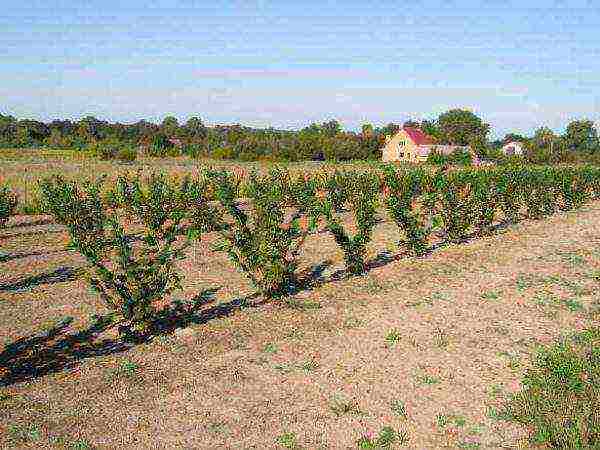
Hazelnuts grow equally well on flat areas and mountain slopes. Due to the developed fibrous root system, the plant is planted specifically in places where it is necessary to prevent soil erosion. When planting on a site for hazelnuts, you can take any place that is not suitable for other horticultural crops.
An important requirement that must be observed when choosing a landing site is good illumination. Hazelnuts can grow in shaded areas, but then you should not hope for a good harvest.... Only the presence of a large amount of natural light contributes to abundant fruiting.
When planting on slopes for "cultured hazel", you can determine the place on any side except the south. It would seem that the south side is better lit and suitable for a plant that loves light. In fact, in early spring, in bright sunlight, flower buds bloom ahead of schedule, and then die during spring frosts.
The culture is sensitive to through winds, therefore when determining the site for planting, the areas that are maximally protected from drafts are selected... Walls of buildings or hedges are used as protection from the wind.
When planting several seedlings, the distance between them and to the nearest trees with a voluminous crown is maintained at least 4-5 m, depending on the size of the future plant in adulthood.
Landing technology
According to information from horticultural guides, seedlings of "cultivated hazel" can be planted in early spring (March-April) or in autumn. Hazelnuts have a short dormancy period, their buds move out earlier than other trees, and most of the plants planted in spring do not take root.
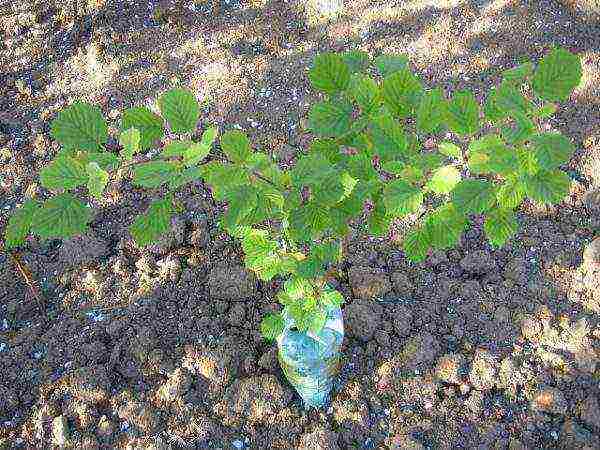
Experienced gardeners are more inclined towards autumn planting - in October-November. Dates for each area are determined individually, depending on weather conditions... In any case, the autumn planting is carried out a month before the onset of frost.
For autumn planting, a hazelnut planting pit is prepared since spring, if the planting of a seedling is planned for the spring, then the preparation is carried out in the fall. This technique allows the weed-free soil to rest and to accumulate a sufficient amount of moisture. Often, life makes adjustments to our plans, and if the decision to plant hazelnuts came spontaneously, the planting pit can be prepared at least two weeks before planting or immediately before planting.
The landing pit is dug 0.6 x 0.6 x 0.6 m in size. Organic and mineral fertilizers are introduced into the prepared pit and mixed well with the ground:
- humus - 2-3 buckets;
- double superphosphate - 150-200 g;
- potassium sulfate - 50-70 g.
Compliance with the recommendations for soil preparation will provide the seedling with sufficient nutrition for 3-4 years.
It is more convenient to plant hazelnuts with an assistant: one holds the plant and straightens the root system, the other carries out all the necessary manipulations. Planting technology is simple:
- If the roots of the seedling were processed in a clay mash, wash the clay from the roots... Dipping in a chatterbox is only necessary to retain moisture in the roots until the moment of planting.
- If the roots of the plant are a little dry, first put them in the water for 1-2 days... Drying of the roots is evidenced by the shriveled bark of the shoots.
- If the roots are significantly dry, then not only them, but the entire seedling should be immersed in water for 1-2 days until the bark becomes smooth.
- Form a landing mound in the center of the pit, stick a peg into it.
- Place the seedling next to the peg, carefully spread the roots of the plant throughout the pit... The root collar of the seedling during planting should be slightly above the soil level. After watering, the ground will settle, and the root collar will be leveled to the ground. This is very important - when the root collar is buried in the ground, the hazelnuts will develop poorly, and may not produce fruits at all.
- They fill up the hole in two passes... First, half of the hole is covered with soil, the earth is tamped a little and generously watered. Then the rest of the pit is poured, tamped again and watered again. The total amount of water for each seedling is at least 25 liters, optimally depending on weather conditions - 30-40 liters.
- Check the level of the root collar - maximum permissible excess above ground level is 1-3 cm.
- The seedling is tied to a peg and cut over 5-6 buds... The height of the aboveground part should be 20-25 cm. Pruning promotes the development of several fruitful shoots during the growing season.
Care of a young seedling
A near-stem circle with a radius of 0.5 m is mulched with peat, humus, manure or sawdust, leaving a free space of 5 cm near the stem. The mulch layer is usually 7-10 cm.
Hazelnut does not tolerate stagnant water, but at the same time it is a moisture-loving plant. Therefore, in the first time after planting, regular and abundant watering is of great importance for the growth of the seedling.The first time the plant is watered a week after planting, take a 7-10-day break and watered again. After that, you can be sure that the planting ball forms a single whole with the rest of the soil and will be able to retain the necessary moisture.
In the first 2-3 winters, hazelnut seedlings are covered with lutrasil or spunbond... This protects the plant from freezing and breaking out unripe shoots.
Further care and cultivation
From planting a seedling to the beginning of fruiting, depending on the variety, you will have to wait 3-4 years. The harvest will be small at first, but in 1-3 years, picking nuts will delight you with its abundance, and after 10 years it will be possible to collect a bucket of nuts from each bush. You can hope for abundant fruiting if the necessary measures for the care of hazelnuts are taken.
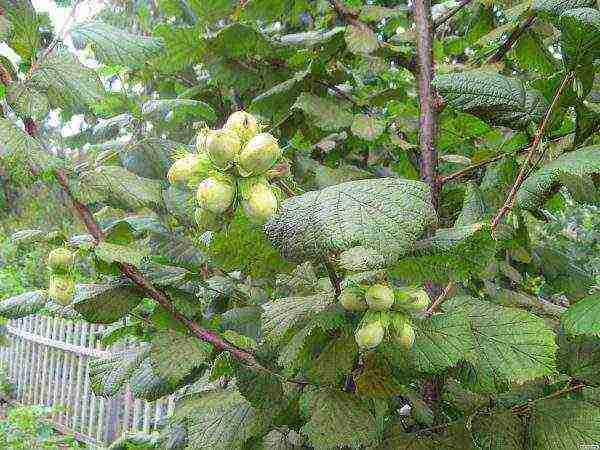
Watering
During the growing season, the plant is watered 1-2 times a month, the total number of waterings since April is 5-6 times... The last time the shrub is watered after the leaves fall - this will create a charge of moisture necessary for the plant in the soil for the next spring. In June and July, the need for moisture increases due to the growth of fruits and the laying of the generative organs of the harvest of the next season, therefore, hazelnuts are watered twice in these months. For watering, use 40-50 l warm water for each bush.
Weeding and mulching
Weeding helps to kill weeds and to saturate the root system with air. When loosening the soil, it must be borne in mind that most of the roots come close to the surface. Damaged hazelnut roots are not restored, so the depth of weeding is 8-10 cm... The soil of the trunks is mulched with peat, sawdust, and dry grass.
Pruning
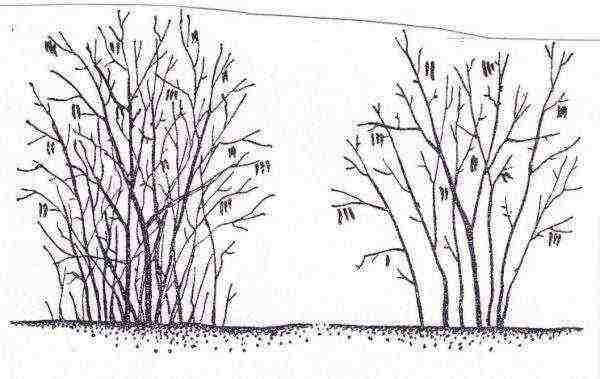
Pruning is necessary to form the shrub. During each summer season, extra shoots are cut, leaving 8-10 of the strongest... They try to remove shoots located inside the bush, as well as weak and damaged ones.
Hazel pest control
For hazelnuts from pests, the hazel weevil and hazel barbel are dangerous. Signs of their appearance are "worminess" and premature drying of the fruit. Insect control uses systemic insecticides, carrying out processing in early May, when the beetles appear in large quantities, and in mid-June, when the nuts protrude from the plyuska. Of the diseases, powdery mildew is most often found, which can be eliminated by treatment with colloidal sulfur, lime-sulfur broth or store-bought fungicidal agents, as well as timely cleaning of infected fruits and fallen leaves.
The reader may get the deceptive impression that planting and growing hazelnuts is a rather troublesome task. In this article, we have tried to give as much information as possible useful for owners of summer cottages and their own estates. Hazelnuts do not need a special temperature regime, they can grow on almost any soil and withstand the lack of dressing... It is enough to make a minimum of effort, and the plant will thank you with a generous harvest of tasty and healthy nuts.


